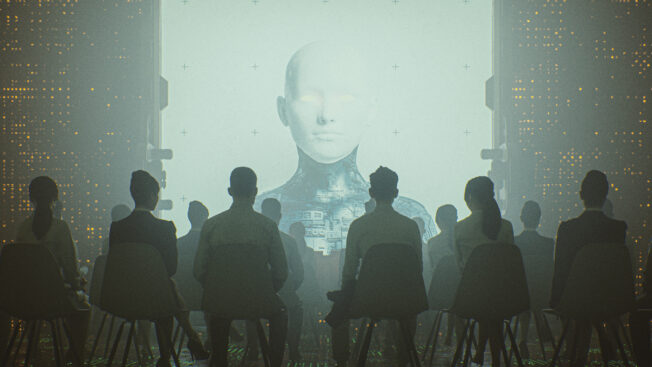How Creator Agencies Prepare for a ‘Deepfake Summer’
Mark your calendar for Mediaweek, October 29-30 in New York City. We’ll unpack the biggest shifts shaping the future of media—from tv to retail media to tech—and how marketers can prep to stay ahead. Register with early-bird rates before sale ends!
Artificial intelligence influencers offer a cost-effective, continuous presence on social media, and save time for brands running user-generated content campaigns.
However, the rise of synthetic influencers has sparked concern among human influencers, who fear that these digital competitors will erode their income from brands.
The spotlight on deepfakes featuring real-life influencer Ariel Marie promoting GetDirty wipes on social media drew attention to the impact of synthetic content. Marie’s consented doppelgänger, created by deepfake ads platform Arcads, showcased the potential of this technology to disrupt influencer marketing.
At influencer agency Open Influence, creators have not yet explored signing brand deals using their deepfakes, according to Maggie Reznikoff, the agency’s vice president, account management. Open Influence hasn’t been approached by Arcads directly, but it has received pitches from AI companies offering services such as cloning influencer voices in multiple languages or advanced video editing tools.
“It’s concerning,” Whalar Group co-founder and co-CEO James Street told ADWEEK. “There are definitely creators out there that would happily give their creative license to be used across the internet, since it allows you to be everywhere at once, in different languages, geographies, and appeal to different audiences.”
Street anticipates that up to 10% of the creator economy could be composed of AI influencers, with companies like Arcads working more with influencers that live on platforms like Fiverr looking to scale brand deals.
With major global events such as the Olympic Games and the U.S. presidential election on the horizon, deepfakes are slowly infiltrating social media platforms, requiring brands to take proactive measures to safeguard their reputation. Creator agencies already experimenting with AI to streamline workflows may build their own tech.
“It’s going to be a deepfake summer,” said Gartner vp analyst Nicole Greene. “We’re going to be at this interesting point where the technology is so sophisticated, it’s going to be hard to tell what’s real and what’s not.”
The growing deepfake market
Arcads—using HeyGen’s technology to create hyper-realistic AI influencers and ElevenLabs for text-to-speech solutions—works like Shutterstock, featuring a catalog of influencer options on its platform.
The company has signed formal contracts with creators to license their likeness, offering a one-time payment as compensation, Arcads co-founder Romain Torres told ADWEEK.
Arcads works with ecommerce brands, gaming companies like Voodoo, dating application Tinder (according to its website) and ad agencies to scale their UGC marketing efforts by creating hundreds of videos within seconds.
Since its launch in early 2024 with 10 employees, Arcads has executed hundreds of brand campaigns. However, creators don’t get to see or validate the final output generated by the platform. Torres didn’t disclose specifics due to client confidentiality.
“We’re investing in a [brand’s] capacity to produce good creative and ads that is otherwise a time-consuming process,” he said.
And the amount of deepfake tech available is growing, with HeyGen competitors cropping up like Soul Machines and Synthesia, which develop affordable AI tools for commercial applications, including creating social media ads.
The global deepfake AI market, valued at $6.83 billion in 2023, is expected to grow significantly, reaching $119.34 billion in the next decade, according to Spherical Insights & Consulting.
Despite fears among real influencers, companies like Arcads argue that it’s simply disrupting an overly inflated market, adding that there is demand to use AI to generate more content efficiently, and content creators are constantly seeking ways to produce high-quality content at a faster pace, said Torres.
“These creators need [AI] tools to scale activity. And that’s inevitable,” he added.
Cost vs. creative
The ad industry has used synthetic talent for years; virtual influencer Lil Miquela has been inking deals with brands like Prada and Calvin Klein since 2016.
According to Gartner, brands paid 73% less than the industry standard rate for real-life influencers ($100 per 10,000 followers) to reach Lil Miquela’s 3 million followers on Instagram. That worked out to $8,000 per post.
However, virtual doppelgängers have limitations in the influencer market, said Reznikoff.
“It won’t be able to replace the creativity or that trust that real influencers bring,” she added.
Open Influence is sharing resources with creators to get brand deals while growing distribution to help scale content, such as cutting clips from longer YouTube videos across Pinterest and Instagram Reels.
Reznikoff expects brands to lean into influencer deepfakes for top-of-funnel campaigns such as videos showcasing product features.
“Where the difference is, and why the market is slightly protected in the creator space, is the fact that it’s very hard to build an audience,” Street said. “I don’t think an AI influencer can just come along and build an audience without a lot of human interaction.”
https://www.adweek.com/media/how-creator-agencies-prepare-for-a-deepfake-summer/
